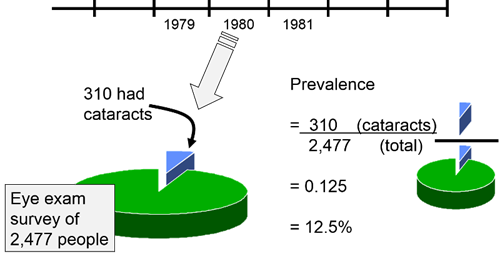2. Prevalence - How many people are affected?
| Site: | EUPATI Open Classroom |
| Course: | Epidemiology and Pharmacoepidemiology |
| Book: | 2. Prevalence - How many people are affected? |
| Printed by: | Guest user |
| Date: | Tuesday, 3 June 2025, 3:17 AM |
1. Ways to measure and report prevalence
(This section is organised in the form of a book, please follow the blue arrows to navigate through the book or by following the navigation panel on the right side of the page.)
To estimate prevalence, researchers randomly draw a sample (smaller group) from the entire population they want to describe. Using random selection methods increases the chances that the characteristics of the sample will be representative of (similar to) the characteristics of the population and allow extrapolating the results to the population.
Bear in mind that in the nomenclature the term “population” is commonly used but in reality, mostly means a representative sample from a population.
There are several ways to refer to prevalence depending on the timeframe of the measurement:
- Point prevalence: the proportion of a population that has a health event at a particular point in time. It includes all previous cases who still have the condition and are still members of the population. A good way to think about point prevalence is to imagine that you took a snapshot of the population and determined the proportion of people who had the condition of interest at the time the snapshot was taken. For example, in a survey you would be asked if you are currently smoking.

- Period prevalence: is similar to point prevalence, except that the "point in time" is broader. It is the proportion of a population that has a health event during a given time period, often 12 months. For example, in a survey you would be asked if you have smoked during the past 12 months.
- Lifetime prevalence: the proportion of a population who, at some point in life has ever had the health event. For example, in a survey, you would be asked if you have ever smoked.
2. Calculating prevalence
Usually, the first question about a certain health event will be: How many people are affected? Or what is the prevalence?
Depending on the population we are looking at, the answer will differ. As an example, look at the following table which will show that the raw number of cases of a health event alone will have only limited value.
Let’s say that there are 10,000 cases of a health event in county A and 20,000 cases in county B. Could we state that the health problem is far more serious in county B? Let’s have a look on the table:
|
|
County A |
County B |
|
Persons affected by a certain health event |
10.000 |
20.000 |
|
Total population of the county |
20.000 |
200.000 |
In county A, a total of 10,000 out of a population of 20,000 are affected, which means that 50% are affected by the health event.
In county B, a total of 20,000 out of a population of 200,000 are affected, which means that 10% are affected by the health event.
The underlying equation to calculate this (the prevalence) would be:

* for point prevalence replace “during a given time period” with “at a particular point in time”
The value of 10n is usually 100 [102], giving a percentage (in general used for common attributes). The value of 10n might be 1,000 [103], 100,000 [10
5], or even larger for rare characteristics and for most diseases.
While our first impression would be that 20,000 are twice as many as 10,000 (which is definitely true!), we now arrive at a very different picture, as we include the population in the equation. In fact, the health problem now looks to be much more severe in the county where in absolute numbers much fewer people are affected.
Rather than as a percentage, we can describe prevalence as the number of people affected in a standard sized population, for example 1,000 people. So, for the above, instead of using 100, which gives the percentage, we could calculate:

The calculation tells, that in country A 500 in 1,000 people would be affected. In country B 100 in 1,000 people would be affected. Here the denominator is 1,000. Usually, in standard reports the denominator is 100,000.
Consequently, the concept of prevalence is that prevalence is a measure of the proportion of the population that has a given disease, condition, or characteristic at a given time.
The following example, adapted from the Boston University School of Public Health [1] illustrates the concept of period prevalence further:
Suppose that residents of Framingham, MA were examined to establish the proportion of the population that had cataracts. In 1980 the Framingham Heart Study examined 2,477 subjects for cataracts and found that 310 had them. So, the prevalence was 310/2,477 = 0.125.

This can be expressed as 12.5 per 100 or 12.5% (per cent means 'per hundred'). Since the examination of these persons took place over a year, it might be referred to as a period prevalence. The prevalence over this observation period would include people who had acquired cataracts previously, and it would also include new cases, i.e., those who had developed cataracts during the year period when the eye exams were conducted. Note that all people counted in the numerator are also included in the denominator, i.e., the numerator is a subset of the denominator.
[1] Course: Measures of Disease Frequency, Wayne W. LaMorte, MD, PhD, MPH, Boston School of Public health https://sphweb.bumc.bu.edu/otlt/mph-modules/ep/ep713_diseasefrequency/EP713_DiseaseFrequency3.html
3. Points to consider
- Note that prevalence is a proportion and not a rate, although the latter term is often used. So, the term "prevalence rate" is technically incorrect because there is no time period included.
- Prevalence is a useful measure of the situation of a disease. Knowing about the prevalence of a specific disease can help us to understand the demands on health services to manage this disease in a population.
- Prevalence changes when people with the condition are cured or die. Bear in mind that increased prevalence doesn’t necessarily mean a bigger problem. Higher prevalence could mean a prolonged survival without cure or an increase of new cases, or both. A lower prevalence could mean that more people are dying rather than being cured, a rapid recovery, and/or a low number of new cases.
- Prevalence is often used when measuring chronic diseases which are characterised by a long duration and difficulty in determining the exact date of onset.